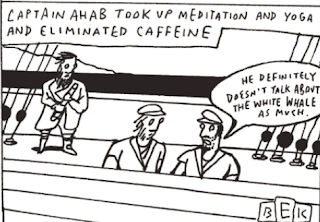 |
| from New Yorker, 13 April 2020 |
Some of my Facebook friends have no doubt noticed that I periodically share a cartoon that employs the images of Captain Ahab and/or Moby-Dick. (I shared one today--see pic at the top of this post.) The captain and his white whale continue to endure in the comics--if not necessarily on the book shelves.
As I kid I read Moby-Dick in its Classics Illustrated comic-book format. I read it lots of times then--an exciting story of a crazy guy chasing a white whale--and losing all in the process.
Later, in high school, I had a bizarre schedule one year: four consecutive study halls in the afternoon. I really had no excuse for not having my homework done, did I? Sure I did: sloth.
Up in front of the Hiram High School study hall was the little school library, and I would often go up there, browse through, oh National Geographic (hmmmm, wonder why?), The Saturday Evening Post (loved the cartoons), and other magazines.
Or I'd check out a book to read--usually something about cowboys or baseball players.
But then that John Huston film of Moby-Dick came out in June 1956 (I had just finished sixth grade, and we were moving from Enid, Oklahoma, to Hiram, Ohio, where my dad would teach at the college). That film arrived in Hiram (where the college sponsored Sunday night movies) on November 11, 1956 (my 12th birthday!); I saw it and loved all the action. Oh, Gregory Peck as Ahab! Link to some video. And, checking IMDB, I see that Orson Welles was in it, as well--I'd totally forgotten that.
So perhaps that memory, still percolating in my head a few years later, sent me over to the M's in the Hiram High library, where I pulled from the shelf Moby-Dick and took it back to my desk, which, appropriately, was, like all the others, bolted to the floor.
And I read it.
Sort of. I'm certain that at age 15 (or so) there were vast portions of it I could not have comprehended; there were numerous words whose meanings I didn't know (and couldn't infer) and so ... skipped.
But--with those, uh, exceptions--I read it. My parents, I'm sure, were stunned.
I've read it quite a few times since: college, grad school, later on for pleasure and/or edification.
When I was teaching at Western Reserve Academy the final decade of my career (2001-11), I taught Melville's story "Benito Cereno" (about a revolt aboard a slave ship), so I read a lot by and about Melville during those years. I read all of his other works (even that endless poem Clarel) and every major biography of him (and some minor ones, too). And some modern versions, too--like Sena Jeter Naslund's Ahab's Wife: Or, The Stargazer (1999).
Anyhow, there's something about that story that has engaged the American imagination. Even though many people have probably not read it, the images of Ahab, of the white whale, are so firmly entrenched in our cultural memory that we can look at a cartoon about the book--and there are many--and smile.
First printings of the book (1851) remain real collectors’ items. Dedicated to Melville's friend Nathaniel Hawthorne, the book did not sell well. (That's generous: It sold poorly.) In fact, Melville's career began its nose-dive about then. By the time he died in 1891 (he'd been working as a customs inspector in NYC), he was pretty much gone from the prominence he'd earned with his earlier works--like Typee (1846). Many apparently thought he'd died years before.
So, if you're thinking of picking up a first printing to give, say, to your former English teacher, be prepared: I just checked, and a good one is going for about $84,000 on abebooks.com.
 |
| the $84,000 copy |
So maybe we should end with a little more humor--yet another Moby-Dick cartoon, this one from August 2014.




No comments:
Post a Comment